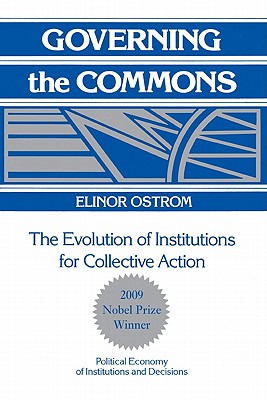Governing the Commons: The Evolution of Institutions for Collective Action
Elinor Ostrom

This work is, for me, a model of great social science work. As someone thinking of going to an economics PhD program in the not-so-distant future, I will definitely benefit from having this book in the back of my mind.
The topic of the book is common-pool resources (CPRs)–which economists define as resources that are “rival” (if I take some of it, that reduces the supply available to anyone else) but “non-excludable” (it is difficult to prevent people from making use of it). A classic example of this, and one among those studied by Ostrom, is a fishery–there are only so many fish, but with a big enough area, it’s pretty difficult to police boundaries or restrictions.
The mainstream economics literature, and because of it much popular commentary, has focused on such resources from a set of related perspectives referred to as “the prisoner’s dilemma” and “the tragedy of the commons.” These models suggest that in some CPR situations, individuals acting in their rational self-interest will end up making decisions that are sub-optimal from a group point of view–generally, overusing the resource. As we can observe with most deep-sea fisheries, this is often indeed the case. But Ostrom’s interest lies in those cases where the predictions of these classic models do not come true: situations where a group of people has established a durable voluntary system for regulating use of the CPR, which neither resorts to privatization nor external regulation (the two preferred remedies of the tragedy-of-the-commons crowd).
Ostrom’s style is extraordinarily appealing to me. Though the book is relatively recent, she writes in what I would call a “classic” style reminiscent of Smith or Keynes. She works systematically and logically, frequently making use of fundamental concepts of economics (for instance, discount rates), but the book is free of equations or mathematical models. I am sure that Ostrom was conversant in mathematical modeling, and used it in her academic papers, but it is a testament to the significance of her ideas that she was able to express them in this way yet have the book retain a strongly academic (that is, not “popular”) character.
I also really appreciated the perspectives Ostrom took on models and math–something Smith and Keynes didn’t have the opportunity to do because of the state of the discipline in their time. She talks persuasively about the model as metaphor. For example, she discusses the way that the prisoner’s dilemma has become such a dominant way of thinking about collective challenges, despite the fact that it is highly specialized and requires that the payoffs be just so, because of the captivating counterintuitiveness of the result. She talks quite compellingly about the way economists tend to take the perspective of “the state”, and how often economic models assume that individuals will be self-centered and myopic while the technocrats in the government will be wise and far-sighted.
In addition to these matters of taste, this book is filled with interesting concepts, and particularly, applications of concepts from other disciplines to economics. I will just mention: quasi-voluntary compliance, second-order collective action problems, the effects of discount-rate heterogeneity, incomplete utility functions.